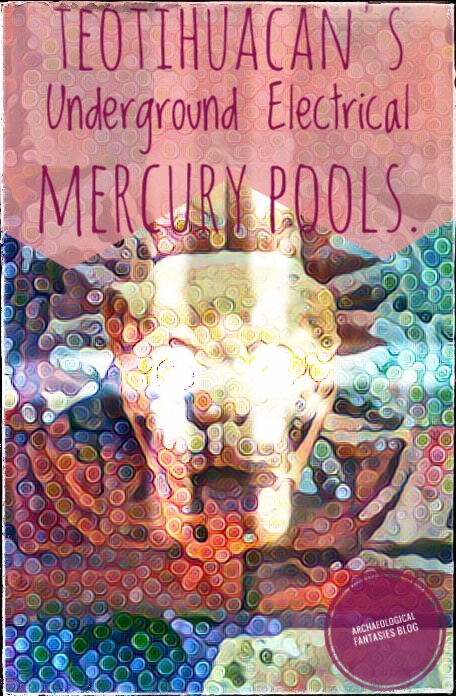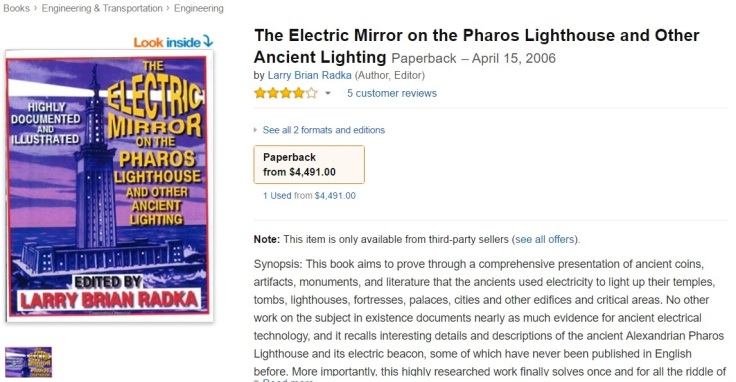
The 6th article in the Lost History of Ancient America is titled “An Ancient American Mexican Pyramid’s Liquid Mercury” by Frank Joseph.
Like the other articles in the edited volume, this one is brief and short on citations or evidence. What evidence that is offered is re-interpreted to try and hold up Joseph’s buried argument that Europeans brought electricity to the Mesoamerica by teaching them how to use liquid mercury to conduct it. He offers no reason for why or how this happened, and you have to read the final two paragraphs to even understand that this is the overall argument of the article in the first place.
Joseph begins with the 2015 discovery of traces of liquid mercury under the Temple of Quetzalcoatl also known as the Feathered Serpent Pyramid in ancient Teotihuacan. This discovery, made by Julie Gazzola and Sergio Chavez Gomez, director of the Tlalocan Project (Villarreal N.d.), and a graduate student with Mexico’s National Institute of Anthropology and History, was only part of the massive and interesting excavations of an underground tunnel that appears to run from the courtyard in front of the main facade of the temple, to well under the temple itself (Yuhas 2015, Zorich 2015). Gomez discovered the entrance to the tunnel in 2003, and has since discovered five underground chambers, each filled with artifacts, offerings, animal skeletons, and other items that show the importance of women in Teotihuacan society as well as the long reach of their trade (Vance 2014, Yuhas 2015, Zorich 2015). Gomez and his cohorts speculate that the mercury could represent water in the underworld for the Mesoamericans (Yuhas 2015). It could also mark the possible burial chamber of a monarch, or the presence of an important ritual chamber (Vance 2014, Yuhas 2015, Villarreal N.d.).
Joseph attempts to tie this discovery to the tomb of Qin Shi Huang Di (sic) or as it’s better known the Mausoleum of the First Qin Emperor, Qin Shi Huang (Unesco N.d). This is the same burial complex where the Terracotta soldiers were uncovered. The exposed burial complex, for it is truly a massive undertaking, mirrors the layout of the imperial city of Qin Shi Huang’s time (Unesco N.d). This mirroring reportedly includes using liquid mercury to mimic the lakes and rivers of the Qin’s China (Unesco N.d).
Now, there have been readings taken of the mound over the location of the burial mausoleum, and they do show incredibly high readings of mercury (Qingbo 2007, Moskowitz 2012). However, the ground entombing the mausoleum has not been breached (Moskowitz 2012), and at the time of this writing, we do not know exactly what is going on down there.
That said, this comparison between the Mausoleum of the First Qin Emperor and the Temple of Quetzalcoatl isn’t that far fetched. More importantly however, I don’t believe Joseph placed it in his article to really show a cultural connection. I think this was a setup for a statement that is made later in the article.
But we’re not done with the Temple of Quetzalcoatl yet. Joseph makes an interesting comment about Quetzalcoatl.
“The Feathered Serpent Pyramid is so called because of the exterior representation of an ‘overseas’ culture bearer, who arrived in the distant past from his Homeland across the Atlantic (Joseph 2017)”.
Joseph is speaking about the god Quetzalcoatl here, and I have never seen these attributes assigned to him. Quetzalcoatl is a god of knowledge, the priesthood, the giver of corn, the creator of books and the calendar, sometimes death and reincarnation, but nothing about being an overseas culture bearer. What’s more, Joseph offers no explanation of where he got his interpretation of the engravings around the Temple of Quetzalcoatl, so we don’t know what he means or who he got this apparently erroneous information from. (I’m willing to update this section if solid evidence comes to light to challenge this.)
So we move back from misinterpretation of god traits to the presence of liquid mercury. Joseph informs us that Rosemary Joyce of UC Berkeley says there are other sites in Mexico with liquid mercury in them (Joseph 2017). To this he is right. Dr. Joyce is a recognized expert in Mesoamerica Culture and the presence of mercury has been discovered at other location in the ancient Mesoamerican world. Joyce outlines several of them in her 2015 blog article Liquid Mercury Found Under Mexican Pyramid. What Joseph ignores from all of the articles he no doubt read in order to write his own, is why the mercury was there in the first place.
As we discussed above with Gazzola and Gomez’ discovery in Teotihuacan, mercury probably was used for its mirrors like properties and it’s apparent similarity to water. Both mirrors and water were sacred to Mesoamerica Culture and used in religious ceremonies. Mirrors were seen as being a portal to the underworld or spirit world, one you could look though, but not interact through (Healy and Blainey 2011). They were probably used for scrying and divination as well, and there are written accounts of bowls of water being used for the same purposes (Healy and Blainey 2011). (We simply don’t have the space to cover how important mirrors were, there are libraries full of research that you can read over about this topic, and a Wiki entry that seems to do a fair job of abbreviating it. I’ve even got a few links in the resources section following the blog.)
Mercury no doubt, also held a place of significance. Not only was the liquid form shinny like a mirror and fluid like water, the red ore it was extracted from, cinnabar, was ground up and used as a red paint on the dead and in art (Healy and Blainey 2011). All of this, the mercury, the cinnabar paint, even mirrors, had a logical place in Mesoamerica Culture that Joseph has to willfully ignore in order to push his argument forward.
But now we get to the formation of Joseph’s argument. After hinting at the presence of mercury at various Mesoamerican sites and probably at the Mausoleum of the First Qin Emperor, Joseph is points out that Europeans were manufacturing liquid mercury long before either the Chinese or Mesoamerica even discovered it (Joseph 2017). This is more subtle ground work. Keeping in mind the overall goal of the book this article is in, the implication here is that Europeans were the first to ‘discover’ mercury, and so were the source of this information. Thereby implying that any other culture that also has this information must have gotten it from the Europeans.
Joseph makes a leap of logic that is not supported in anything he’s presented so far. He introduces Larry Brian Radka, a retired broadcast engineer and author of books such as Historical Evidence for Unicorns (1995) and Astonomical(sic) revelations or 666 (1997) . The most recent title I can find for him is, The Electric Mirror on the Pharos(sic) Lighthouse and Other Ancient Lighting (2006) which sells for a mere $4,491.00 on Amazon.

Radka is a big believer in ancient electricity and mostly seems to reinterpret Egyptian hieroglyphs to be light bulbs and lamps.
Next Joseph uses a large quote from the Wikipedia entry on Mercury to try and bolster the argument that Mesoamerica mercury was used for electrical purposes. I want to be bothered by this, but I realize that the differences between linking to a Wiki article for reference and using a Wiki article as evidence might be lost on many, so I’m just going to let this one go.
Lastly, Joseph brings up the discovery of a chamber beneath the Temple of the Sun, also located in the Teotihuacan complex (2017). I’m guessing he’s referring to the 1971 discovery of what appeared to be a cave (Heyden 1975) and has been further explored and expanded on (Sugiyama et al. 2013). The tunnel and chambers beneath the Temple of the Sun appear to follow a similar layout like that under the Temple of Quetzalcoatl (Sugiyama et al. 2013). Joseph claims that there was a shelf full of micro thin wafers of Mica on it. If you know anything about mica, you know it basically peels apart in thin sheets, or flakes very easily like that. It’s almost impossible to keep thick sheets of it together. It’s also naturally shiny and was used by the Mesoamerica as (you guessed it) mirrors (Healy and Blainey 2011).
What I can’t place is Joseph’s claim of “wafer thin Mica that had been imported nearly 2,000 years before from Brazil 4,615 air miles away (Joseph 2017).” The only other place I can find this, besides other fringe sites that are quoting Joseph, is a USA Today fluff piece on Teotihuacan that has no references at all. I do know that mica occurs naturally almost everywhere, so I don’t think there would have been a need for the inhabitants at Teotihuacan to go 4,000 + miles out of their way to find any.
Joseph closes his article with the statement:
“Why would the Teotihuacanos have gone to the immense trouble of bringing such delicate materials from so far away only to conceal them deep underground where they would never be seen? Like liquid mercury, mica has important electrical properties. Perhaps both were employed in tandem to power the “place where Gods become men” (Joseph 2017).”
So much to unpack here, let’s keep it brief. There are two massive, unsupported assumptions here.
1) ‘Teotihuacanos’ were using mercury and mica to electrify Teotihuacan, and
2) That knowledge came from Europeans from across the ocean.
First, aside from the incredible lack of evidence for the use of electricity at Teotihuacan, or Joseph’s lack of an attempt to provide any, Joseph is completely ignoring the cultural significance of both mercury and mica to Mesoamerica culture. This is even more puzzling because the very sources he cites, namely Wikipedia, clearly have sections, with citations, that explain this. Even the 2015 Guardian article by Alan Yuhas, (that I think he used based on terms he mentions in this article) goes to great lengths to explain the cultural significance of mercury. As does Dr. Rosemary Joyce, who Joseph reference by name (but fails to cite), so I can safely assume he read her blog post, since he directly quotes it.
The second part of this is the re-occurring diffusion argument that unnamed Europeans were the fathers of all culture and invention and though transoceanic travel, disseminated it to everyone else. Again, there is a resounding lack of evidence for this, and this article does nothing to add to that.
Summary:
The major argument that Joseph appears to be making here is that the Mesoamericans had the knowledge of electricity, and were using it at Teotihuacan, and that knowledge came from unarmed Europeans from across the ocean. Joseph offers no evidence to support any part of this claim beyond quoting a Wikipedia article about how mercury can be used to conduct electricity in the modern era. There is nothing at Teotihuacan that would suggest the mercury found beneath the Feathered Serpent Pyramid was being used for anything resembling electricity. There is however, ample evidence that both the mercury and the mica at the site fit with the known cultural aspects of Mesoamerican society, and Joseph has offered nothing to challenge that.
If you’d like to support this blog, consider donating on Patreon or PayPal under ArchyFantasies@gmail.com
Want more on this topic? Go to: ArchyFantasies Reviews – The Lost History of Ancient America.
Comment below or send an email to ArchyFantasies@gmail.com.
Resources:
Healy, Paul F. and Marc G. Blainey
2011 Ancient Maya Mosaic Mirrors: Function, Symbolism, and Meaning. Cambridge. Ancient-Mesoamerica, Volume 22, Issue 2
October 2011, pp. 229-244. Published online: 30 December 2011
https://www.cambridge.org/core/journals/ancient-mesoamerica/article/div-classtitleancient-maya-mosaic-mirrors-function-symbolism-and-meaningdiv/72839F6406A1945F07DE2B83BCBFC9E4. DOI: https://doi.org/10.1017/S0956536111000241 Retrieved 3/2/17
Heyden, Doris
1975 An Interpretation of the Cave underneath the Pyramid of the Sun in Teotihuacan, Mexico. http://www.latinamericanstudies.org/aztecs/Teotihuacan-cave.pdf Retrieved 3/2/17
Holloway, April
2015 River of Mercury in Underworld of Pyramid of Quetzalcoatl may lead to Royal Tomb. http://www.ancient-origins.net/news-history-archaeology/river-mercury-underworld-pyramid-quetzalcoatl-may-lead-royal-tomb-002952?nopaging=1 Retrieved 3/2/17
Joyce, Rosemary
2015 “Liquid mercury found under Mexican pyramid”…Berkeley . http://blogs.berkeley.edu/2015/04/25/liquid-mercury-found-under-mexican-pyramid/ Retrieved 3/2/17
Moskowitz, Clara
2012 The Secret Tomb of China’s 1st Emperor: Will We Ever See Inside? Live Science. http://www.livescience.com/22454-ancient-chinese-tomb-terracotta-warriors.html Retrieved 3/2/17
Shaer, Matthew
2016 A Secret Tunnel Found in Mexico May Finally Solve the Mysteries of Teotihuacán. Smithsonian Magazine. June 2016.
http://www.smithsonianmag.com/history/discovery-secret-tunnel-mexico-solve-mysteries-teotihuacan-180959070/ Retrieved 3/2/17
Sugiyama, Nawa, Saburo Sugiyama, and Alejandro Sarabia
2013 Inside the Sun Pyramid at Teotihuacan, Mexico: 2008-2011 Excavations and Preliminary Results. Latin American Antiquity. 24(4), 2013, pp. 403–432. the Society for American Archaeology.
http://www.academia.edu/5495154/Inside_the_Sun_Pyramid_at_Teotihuacan_Mexico_2008-2011_Excavations_and_Preliminary_Results Retrieved 3/2/17
Unesco
N.d. Mausoleum of the First Qin Emperor. Unesco website.
http://whc.unesco.org/en/list/441 Retrieved 3/2/17
Vance, Erik
2014 New Artifact-Filled Chambers Revealed under Teotihuacan
Rooms beneath the mysterious city contain jade statues, jaguar remains and thousands of other objects. Scientific American. https://www.scientificamerican.com/article/new-artifact-filled-chambers-revealed-under-teotihuacan/ Retrieved 3/2/17
Villarreal, Jose
N.d Archaeologists Find Tunnel Below the Temple of the
Feathered Serpent in Teotihuacan. Art Daily.org http://artdaily.com/news/39718/Archaeologists-Find-Tunnel-Below-the-Temple-of-the-Feathered-Serpent-in-Teotihuacan#.VTqBfWR4qHo Retrieved 3/2/17
Yuhas, Alan
2015 Liquid mercury found under Mexican pyramid could lead to king’s tomb. https://www.theguardian.com/world/2015/apr/24/liquid-mercury-mexican-pyramid-teotihuacan Retrieved 3/2/17
Zorich, Zach
2015 Mythological Mercury Pool. Teotihuacan, Mexico. Archaeology magazine online. http://www.archaeology.org/issues/200-1601/features/3958-mexico-teotihuacan-mercury Retrieved 3/2/17



The first big hole I see in his argument is “If Europeans knew about the electrical properties of mercury, why wasn’t it being used that way in Europe?” As far as I know, during the period that the MesoAmerican cultures were active, Europeans were using mercury for alchemy, not electricity. If he had tried to claim that they had brought alchemy to the Americas, he’d at least have a slightly more plausible claim.
LikeLike
Can I take it that the electrified fence around Teotihuacan is what kept the conquistors from conquering it?
LikeLike
I remember finding that unicorn book in a used bookstore once. Flipping through, it was obvious the author was was not a well person.
LikeLike
Great work, I cannot wait to see what you do with Hunter Adams material on Ancient Egypt.
LikeLike
I get what is being discussed from a representation point of view. But to me is sounds like the mica, mercury, water troughs and the gold was a purifying process of amalgamation. Water brought in the troughs to separate the gold from the mercury. Mica as the “heating pad” almost like a proofing room for photographers so to say. The alloys dont need that much heat at that point. And if an animal chamois was used to filter it would be long time degraded by now to indicate that it may have been used in the filtering process. Mercury can be charged, gold is good conductor of electricity, water can make electricity…… its leading back to energy. Large Magnetic fields run through these continents. Just my thoughts
LikeLike